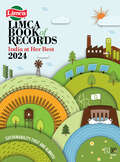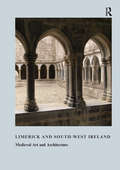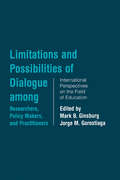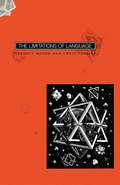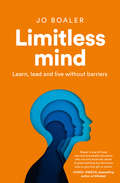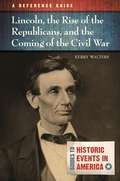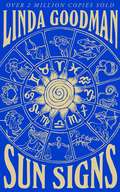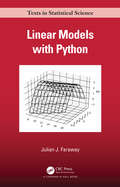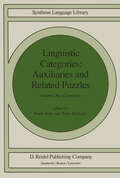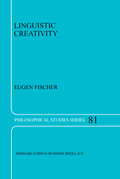- Table View
- List View
Lightning Often Strikes Twice: The 50 Biggest Misconceptions in Science
by Brian CleggA revealing and entertaining guide through some of the biggest misconceptions in science that many of us still believe.You may well be familiar with the fact that lightning, contrary to the popular saying, often strikes the same place twice. But this is just the tip of the iceberg when it comes to what many of us wrongly believe about the way the world works. Whether it’s word of mouth, myths you’ve read about online, or misremembered facts from school, we’re bombarded by misconceptions about the science we come into contact with every day – this book will uncover the most popular myths to help you avoid contributing to the perpetuation of these misunderstandings.Breaking it down into fifty of the most popular misconceptions in science, each chapter of this book will be headed up with a ‘fact’, followed by the real story, providing the science and theory that debunks the myth. From fears about the exponential growth of the human population to the embarrassment of always pointing out the north star as the brightest in the sky, this is the book to read if you want to separate the science fact from fiction.
Likelihood Methods in Survival Analysis: With R Examples (Chapman & Hall/CRC Biostatistics Series)
by Jun Ma Annabel Webb Harold Malcolm HudsonMany conventional survival analysis methods, such as the Kaplan-Meier method for survival function estimation and the partial likelihood method for Cox model regression coefficients estimation, were developed under the assumption that survival times are subject to right censoring only. However, in practice, survival time observations may include interval-censored data, especially when the exact time of the event of interest cannot be observed. When interval-censored observations are present in a survival dataset, one generally needs to consider likelihood-based methods for inference. If the survival model under consideration is fully parametric, then likelihood-based methods impose neither theoretical nor computational challenges. However, if the model is semi-parametric, there will be difficulties in both theoretical and computational aspects.Likelihood Methods in Survival Analysis: With R Examples explores these challenges and provides practical solutions. It not only covers conventional Cox models where survival times are subject to interval censoring, but also extends to more complicated models, such as stratified Cox models, extended Cox models where time-varying covariates are present, mixture cure Cox models, and Cox models with dependent right censoring. The book also discusses non-Cox models, particularly the additive hazards model and parametric log-linear models for bivariate survival times where there is dependence among competing outcomes.Features Provides a broad and accessible overview of likelihood methods in survival analysis Covers a wide range of data types and models, from the semi-parametric Cox model with interval censoring through to parametric survival models for competing risks Includes many examples using real data to illustrate the methods Includes integrated R code for implementation of the methods Supplemented by a GitHub repository with datasets and R code The book will make an ideal reference for researchers and graduate students of biostatistics, statistics, and data science, whose interest in survival analysis extend beyond applications. It offers useful and solid training to those who wish to enhance their knowledge in the methodology and computational aspects of biostatistics.
Likelihood Methods in Survival Analysis: With R Examples (Chapman & Hall/CRC Biostatistics Series)
by Jun Ma Annabel Webb Harold Malcolm HudsonMany conventional survival analysis methods, such as the Kaplan-Meier method for survival function estimation and the partial likelihood method for Cox model regression coefficients estimation, were developed under the assumption that survival times are subject to right censoring only. However, in practice, survival time observations may include interval-censored data, especially when the exact time of the event of interest cannot be observed. When interval-censored observations are present in a survival dataset, one generally needs to consider likelihood-based methods for inference. If the survival model under consideration is fully parametric, then likelihood-based methods impose neither theoretical nor computational challenges. However, if the model is semi-parametric, there will be difficulties in both theoretical and computational aspects.Likelihood Methods in Survival Analysis: With R Examples explores these challenges and provides practical solutions. It not only covers conventional Cox models where survival times are subject to interval censoring, but also extends to more complicated models, such as stratified Cox models, extended Cox models where time-varying covariates are present, mixture cure Cox models, and Cox models with dependent right censoring. The book also discusses non-Cox models, particularly the additive hazards model and parametric log-linear models for bivariate survival times where there is dependence among competing outcomes.Features Provides a broad and accessible overview of likelihood methods in survival analysis Covers a wide range of data types and models, from the semi-parametric Cox model with interval censoring through to parametric survival models for competing risks Includes many examples using real data to illustrate the methods Includes integrated R code for implementation of the methods Supplemented by a GitHub repository with datasets and R code The book will make an ideal reference for researchers and graduate students of biostatistics, statistics, and data science, whose interest in survival analysis extend beyond applications. It offers useful and solid training to those who wish to enhance their knowledge in the methodology and computational aspects of biostatistics.
Lilla's Feast: A True Story Of Love, War, And A Passion For Food
by Frances OsborneLilla Eckford, interned in a Japanese civilian camp in China during the second world war after an extraordinary early life,passed her time by compiling a book about the joys of food.Thisprecious cookery book, now in the possession of the ImperialWarMuseum, inspired Lilla's great-granddaughter, Frances Osborne, to investigate her enthralling story.Lilla's Feast spans the world from China to India and finally to England over a hundred years, and blends together personal history, world events, period atmosphere and family anecdotes into a brilliantly vibrant and poignant story.
Limca Book of Records 2020–22
by Hachette IndiaREAL-LIFE SUPERHEROES.CHAMPIONS AMONG CHAMPIONS.THE MOST OUTSTANDING RECORDS.India's firsts and foremosts, her stellar victories and accomplishments in human endeavour, structures, education, defence, government, science and technology, adventure, business, cinema, the natural world, literature and the arts - discover them all in this landmark volume that marks 30 completed years of the country's only comprehensive book of records.From the longest, tallest and fastest to the unique and truly extraordinary, this curation of superlatives presents an astonishing range of newly set records as well as those that have stood steadfast over the years. Besides infographics, tables and over 700 colour images, the Super 30 and Record Rewind capsules recall golden moments of the past three decades.In our support of a cleaner and greener planet, a new environment and sustainability section spotlights eco-warriors and their earth-friendly feats. Finally, as a tribute to the fight against the pandemic, the Covid-19 feature traces mighty milestones, compassionate actionand innovative ideas that echo the very spirit of the Limca Book of Records - persistence, resilience and triumph in the face of all odds.
Limca Book of Records 2023
by Hachette IndiaWINNERS. CHAMPIONS. ACHIEVERS.THE PRIDE OF THE NATION.Enterprising Indians continue to illuminate our present just as they have lit up our past with their stellar accomplishments and achievements. The Limca Book of Records, with curated records of more than 30 years, is a peerless platform to meet a host of them. Find out about our country's firsts and foremosts in every field of human endeavour, including structures, education, defence, government, science and technology, adventure, business, cinema, the natural world, literature and the arts, in India's only comprehensive book of records.This volume of superlatives brings you hundreds of impressive newly set records, reader-friendly infographics, charts and tables, more than 800 images and a wide range of absolutes - such as records for the longest, tallest, fastest and heaviest - that have endured across decades. As a tribute to 75 years of Independence, this editionalso carries a special section, along with fascinating facts highlighting India at her best throughout the book. Plus, youcan stay updated with a chapter on Indian states and Union Territories, and a recap of the 2022 Commonwealth Games!Be informed. Be proud.Most of all, be inspired!
Limca Book of Records 2024
by Hachette IndiaIndia's longest-running record book completing 34 yearsFEATS OF EXTRAORDINARY TENACITYSTORIES OF STUNNING PERFORMANCESTRIUMPHS OF NEVER-SAY-DIE ACHIEVERSIndia's most comprehensive book of records captures the country's stellar achievements in human endeavour, structures, sports, education, defence, government, science and technology, adventure, business, cinema, environment and sustainability, literature, and the arts. From the longest, tallest, and fastest to the unique and truly extraordinary, this curation of superlatives presents a remarkable range of newly set records and those that have stood steadfast over the years. A recap of the record-breaking show at the Asian Games 2022 and a focus section on Indian Parliament make this edition extra special. Records in the conservation of the environment and betterment of our communities, among others, are sure to resonate and motivate readers. This edition of India's number one record-cum-reference book, with over 450 coloured images, is packed with informative timelines, reader-friendly infographics, tables, and number trivia. Limca Book of Records 2024 promises to thrill, enrich, and entertain! ... as always!
Limerick and South-West Ireland: Medieval Art and Architecture
by Roger StalleyThis book contains essays devoted to the medieval art and architecture of Limerick in the Munster province of South-West Ireland. It underpins the degree to which Irish craftsmen and builders engaged with the rest of Europe, and the nature of their relationship with English practice.
Limerick and South-West Ireland: Medieval Art and Architecture
by Roger StalleyThis book contains essays devoted to the medieval art and architecture of Limerick in the Munster province of South-West Ireland. It underpins the degree to which Irish craftsmen and builders engaged with the rest of Europe, and the nature of their relationship with English practice.
Limitations and Possibilities of Dialogue among Researchers, Policymakers, and Practitioners: International Perspectives on the Field of Education (Studies in Education/Politics)
by Mark B. Ginsburg Jorge GorostiagaThe chapters in this edited volume raise important issues of the relation between research and its various external "publics".
Limitations and Possibilities of Dialogue among Researchers, Policymakers, and Practitioners: International Perspectives on the Field of Education (Studies in Education/Politics)
by Mark B. Ginsburg Jorge M. GorostiagaThe chapters in this edited volume raise important issues of the relation between research and its various external "publics".
The Limitations of Language
by Terence Moore Chris Carling Anna Larsson Trevor Cribben MerrillThis book explores the relation between language and our senses and emotions, taking readers into domains as diverse as wine-tasting, marriage guidance counselling, medical training and face recognition. The authors suggest that language is capable of both confusing and clarifying.
Limitless Mind: The New Science Of Learning, Mindset And Human Potential
by Jo BoalerWhen we learn, we change what we believe and how we interact with the world. This changes who we are as people and what we can achieve.
The Limits of Logical Empiricism: Selected Papers of Arthur Pap (Synthese Library #334)
by Alfons Keupink Sanford ShiehThis volume collects some of the most significant papers of Arthur Pap. Pap’s work played an important role in the development of the analytic tradition. This goes beyond the merely historical fact of Pap’s influential views of dispositional and modal concepts. Pap's writings in philosophy of science, modality, and philosophy of mathematics provide insightful alternative perspectives on philosophical problems of current interest.
Lincoln, the Rise of the Republicans, and the Coming of the Civil War: A Reference Guide (Guides to Historic Events in America)
by Professor Kerry WaltersThis succinct and readable account of the heated debate over the expansion of slavery provides readers with a thorough understanding of how the Civil War was precipitated.This book vividly depicts and clearly explains the events in the decades leading up to the Civil War that resulted from the controversy over expansion of slavery into the western territories. The chapters describe how this single issue drove a wedge through the country and spawned the creation of several new political parties, including the Republican Party; caused furious congressional debates; sparked violence in Kansas; increased sectional discord between North and South; and allowed Abraham Lincoln to rise from relative obscurity to become the first Republican president of the United States. The work also supplies two-dozen thumbnail sketches of the period's greatest statesmen and less-than-great presidents, including individuals such as James Buchanan, John C. Calhoun, Salmon P. Chase, Henry Clay, Stephen Douglas, and William Henry Seward.
Lincoln, the Rise of the Republicans, and the Coming of the Civil War: A Reference Guide (Guides to Historic Events in America)
by Professor Kerry WaltersThis succinct and readable account of the heated debate over the expansion of slavery provides readers with a thorough understanding of how the Civil War was precipitated.This book vividly depicts and clearly explains the events in the decades leading up to the Civil War that resulted from the controversy over expansion of slavery into the western territories. The chapters describe how this single issue drove a wedge through the country and spawned the creation of several new political parties, including the Republican Party; caused furious congressional debates; sparked violence in Kansas; increased sectional discord between North and South; and allowed Abraham Lincoln to rise from relative obscurity to become the first Republican president of the United States. The work also supplies two-dozen thumbnail sketches of the period's greatest statesmen and less-than-great presidents, including individuals such as James Buchanan, John C. Calhoun, Salmon P. Chase, Henry Clay, Stephen Douglas, and William Henry Seward.
Linda Goodman's Sun Signs: The Secret Codes of the Universe
by Linda GoodmanThe original bestseller from the world's most respected astrological authorityEmbark on your cosmic path to self-discovery with this comprehensive guide to the twelve signs of the zodiac.Your sun sign is determined by the day and month of your birth and is the foundation of your horoscope. Taking each of the twelve signs in turn, world famous astrologer Linda Goodman explains the importance of the sun – the most powerful of all stellar bodies. She describes the characteristics of each sign and how these can be used to really get to know the men, women, children, bosses and employees in your life. This newfound knowledge allows us to feel closer to one another and to understand that, as Goodman says, ‘Not all Capricorns are meek, not all Leos are outwardly domineering and not all Virgos are virgins.’ Learn all this and much, much more from the world-famous astrologer who has helped millions divine their way to success, happiness and love by studying the sun signs.Before publication of Sun Signs in 1968, astrology as we know it had a very limited following in the United States and around the world. With this book, Linda Goodman changed that forever, bringing metaphysical consciousness to millions of readers around the world for the first time. Newspapers began running astrology columns, and Goodman herself contributed to these in the larger mass circulation women's magazines. An increasing number of people knew their sign and how to interpret the signs of others, introducing the study of astrological tendencies as we now know it.
Linear Models with Python (Chapman & Hall/CRC Texts in Statistical Science)
by Julian J. FarawayPraise for Linear Models with R: This book is a must-have tool for anyone interested in understanding and applying linear models. The logical ordering of the chapters is well thought out and portrays Faraway’s wealth of experience in teaching and using linear models. … It lays down the material in a logical and intricate manner and makes linear modeling appealing to researchers from virtually all fields of study. -Biometrical Journal Throughout, it gives plenty of insight … with comments that even the seasoned practitioner will appreciate. Interspersed with R code and the output that it produces one can find many little gems of what I think is sound statistical advice, well epitomized with the examples chosen…I read it with delight and think that the same will be true with anyone who is engaged in the use or teaching of linear models. -Journal of the Royal Statistical Society Like its widely praised, best-selling companion version, Linear Models with R, this book replaces R with Python to seamlessly give a coherent exposition of the practice of linear modeling. Linear Models with Python offers up-to-date insight on essential data analysis topics, from estimation, inference and prediction to missing data, factorial models and block designs. Numerous examples illustrate how to apply the different methods using Python. Features: Python is a powerful, open source programming language increasingly being used in data science, machine learning and computer science. Python and R are similar, but R was designed for statistics, while Python is multi-talented. This version replaces R with Python to make it accessible to a greater number of users outside of statistics, including those from Machine Learning. A reader coming to this book from an ML background will learn new statistical perspectives on learning from data. Topics include Model Selection, Shrinkage, Experiments with Blocks and Missing Data. Includes an Appendix on Python for beginners. Linear Models with Python explains how to use linear models in physical science, engineering, social science and business applications. It is ideal as a textbook for linear models or linear regression courses.
Linear Models with Python (Chapman & Hall/CRC Texts in Statistical Science)
by Julian J. FarawayPraise for Linear Models with R: This book is a must-have tool for anyone interested in understanding and applying linear models. The logical ordering of the chapters is well thought out and portrays Faraway’s wealth of experience in teaching and using linear models. … It lays down the material in a logical and intricate manner and makes linear modeling appealing to researchers from virtually all fields of study. -Biometrical Journal Throughout, it gives plenty of insight … with comments that even the seasoned practitioner will appreciate. Interspersed with R code and the output that it produces one can find many little gems of what I think is sound statistical advice, well epitomized with the examples chosen…I read it with delight and think that the same will be true with anyone who is engaged in the use or teaching of linear models. -Journal of the Royal Statistical Society Like its widely praised, best-selling companion version, Linear Models with R, this book replaces R with Python to seamlessly give a coherent exposition of the practice of linear modeling. Linear Models with Python offers up-to-date insight on essential data analysis topics, from estimation, inference and prediction to missing data, factorial models and block designs. Numerous examples illustrate how to apply the different methods using Python. Features: Python is a powerful, open source programming language increasingly being used in data science, machine learning and computer science. Python and R are similar, but R was designed for statistics, while Python is multi-talented. This version replaces R with Python to make it accessible to a greater number of users outside of statistics, including those from Machine Learning. A reader coming to this book from an ML background will learn new statistical perspectives on learning from data. Topics include Model Selection, Shrinkage, Experiments with Blocks and Missing Data. Includes an Appendix on Python for beginners. Linear Models with Python explains how to use linear models in physical science, engineering, social science and business applications. It is ideal as a textbook for linear models or linear regression courses.
Lingua Universalis vs. Calculus Ratiocinator: An Ultimate Presupposition of Twentieth-Century Philosophy (Jaakko Hintikka Selected Papers #2)
by Jaakko HintikkaR. G. Collingwood saw one of the main tasks of philosophers and of historians of human thought in uncovering what he called the ultimate presuppositions of different thinkers, of different philosophical movements and of entire eras of intellectual history. He also noted that such ultimate presuppositions usually remain tacit at first, and are discovered only by subsequent reflection. Collingwood would have been delighted by the contrast that constitutes the overall theme of the essays collected in this volume. Not only has this dichotomy ofviews been one ofthe mostcrucial watersheds in the entire twentieth-century philosophical thought. Not only has it remained largely implicit in the writings of the philosophers for whom it mattered most. It is a truly Collingwoodian presupposition also in that it is not apremise assumed by different thinkers in their argumentation. It is the presupposition of a question, an assumption to the effect that a certain general question can be raised and answered. Its role is not belied by the fact that several philosophers who answered it one way or the other seem to be largely unaware that the other answer also makes sense - if it does. This Collingwoodian question can be formulated in a first rough approximation by asking whether language - our actual working language, Tarski's "colloquiallanguage" - is universal in the sense of being inescapable. This formulation needs all sorts of explanations, however.
Linguistic and Psycholinguistic Approaches on Implicatures and Presuppositions
by Salvatore Pistoia-Reda Filippo DomaneschiThis book discusses developments in the study of implicatures and presuppositions, drawing on recent linguistic and psycholinguistic literature. It provides original discussions of specific formal aspects of the theoretical reconstruction of these phenomena. The authors offer innovative experimental analyses in which crucial processing questions are addressed, and new experimental methodologies are introduced. The result is an advanced debate featuring broad empirical coverage of the issues, as well as an informed discussion of the connections between a Compositional Semantics and a Pragmatic Theory of Implicit Communication, in light of the empirical data coming from Experimental Semantics and Pragmatics. This book will be a worthwhile read for those with interests in both the formal and methodological aspects of these arguments.
Linguistic and Psycholinguistic Approaches on Implicatures and Presuppositions
by Salvatore Pistoia-Reda Filippo DomaneschiThis book discusses developments in the study of implicatures and presuppositions, drawing on recent linguistic and psycholinguistic literature. It provides original discussions of specific formal aspects of the theoretical reconstruction of these phenomena. The authors offer innovative experimental analyses in which crucial processing questions are addressed, and new experimental methodologies are introduced. The result is an advanced debate featuring broad empirical coverage of the issues, as well as an informed discussion of the connections between a Compositional Semantics and a Pragmatic Theory of Implicit Communication, in light of the empirical data coming from Experimental Semantics and Pragmatics. This book will be a worthwhile read for those with interests in both the formal and methodological aspects of these arguments.
Linguistic Categories: Volume One: Categories (Studies in Linguistics and Philosophy #19)
by Frank Heny and Barry RichardsVIrtually all the papers in these volumes originated in presentations at the Fourth Groningen Round Table, held in July 1980. That conference, organ ized by the Institute for General linguistics of Groningen University was the fourth in an irregular series of meetings devoted to issues of topical interest to linguists. Its predecessor, the Third Round Table, was held in June 1976, and dealt with the semantics of natural language. A selection of the papers was published as Syntax and Semantics 10, Selections from the Third Groningen Round Table, ed. by F. Heny and H. Schnelle, Academic Press, 1979. This fourth meeting was more narrowly focussed. The original intention was to examine the hypothesis of Akrnajian, Steele and Wasow in their paper 'The Category AUX in Universal Grammar', Linguistic Inquiry 10, 1-64. Ultimately the topic was broadened considerably to encompass not only the syntax, semantics and morphology of auxiliaries and related elements, but to tackle the problem (implicit in the original work of Akmajian, Steele and Wasow) of justifying the selection of categories for the analysis of natural language. In the summer of 1979, a workshop and short, informal conference were held at the University of Salzburg, in preparation for the Round Table. These were organized in conjunction with the Summer Institute of the linguistic Society of America. The cooperation of the LSA and of the University of Salzburg, and in particular of the Director of that Institute, Professor Gaberell Drachman, is hereby gratefully acknowledged.
Linguistic Creativity: Exercises in ‘Philosophical Therapy’ (Philosophical Studies Series #81)
by E. FischerSpeakers can get to know the meaning of any of indefinitely many sentences that they have never heard before. This statement encapsulates the problem of linguistic creativity, which lies at the core of philosophy of language and theoretical linguistics. It has also sparked off a considerable amount of work on the philosophy of mind. After establishing the failure of the familiar compositional approach to the problem, the book adopts a radically new start. It develops core elements of the later Wittgenstein's conception of philosophy, putting them to work to`dissolve' the problem, proving it ill-framed by clarifying the questions posing it and breaking the spell of mistaken analogies that inform it. This sharply focused monograph thus has a dual aim: coping with a crucial problem that turns out to be a lot tougher than is generally supposed, and presenting a precise and rigorous demonstration of an unfamiliar and exciting philosophical approach. Audience: Clearly written and lucidly structured, the book addresses professional philosophers and advanced undergraduates alike.
Linguistic Disobedience: Restoring Power to Civic Language
by Yuliya Komska Michelle Moyd David GramlingThis book asks how we—as citizens, immigrants, activists, teachers—can counter the abuse of language in our midst. How can we take back the power of language from those who flaunt that power to silence or erase us and our fellows? In search of answers, Linguistic Disobedience recalls ages and situations that made critiquing, correcting, and caring for language essential for survival. From turn-of-the-twentieth-century Central Europe to the miseries of the Third Reich, from the Movement for Black Lives to the ongoing effort to decolonize African languages, the study and practice of linguistic disobedience have been crucial. But what are we to do today, when reactionary supremacists and authoritarians are screen-testing their own forms of so-called disobedience to quash oppositional social justice movements and their languages? Blending lyric essay with cultural criticism, historical analysis, and applied linguistics, Linguistic Disobedience offers suggestions for a hopeful pathway forward in violent times.





